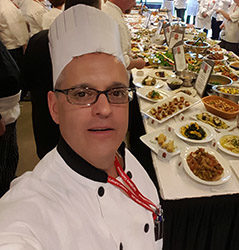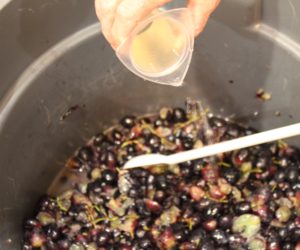Whether on purpose or not, any time you make wine from grapes you are influenced by terroir. That French term, with no direct English translation, describes a sense of place regarding where the grapes are grown. In this column, I will include information on what effects terroir has on white wine, what you can do to influence it, and illustrate with one of my experiments at influencing terroir effects in my backyard Chardonnay.
While there is no single agreed-upon definition, most observers include some common aspects of grape growing in terroir. Climate is prominent, particularly with regard to warmth and rainfall. Geology also plays a prominent part; in mineral composition and underground soil structure in the vineyard. Finally, nearly every definition considers geographic features like bodies of water, slopes, and orientation toward the path of the sun during the growing season. Authors also sometimes include human factors as part of terroir, such as the people who live in a growing region and their culture.
Recognition of terroir began in ancient times. Classical Greek authors identified wines from different regions and recognized quality differences, even from the same grape varieties. The later Roman Empire carried the “sense of place” associated with specific wines throughout Europe. Later still, Benedictine and Cistercian monks established land holdings in what is now Burgundy and began experimenting with influences on wine quality. They tried different grape varieties on different parcels and even went so far as to taste the soil in an effort to characterize it. Specific subdivision of vineyard properties eventually led to the modern AOC or Appellation d’Origine Contrôlée system that defines most French wines today.
The system of American Viticultural Areas or AVAs is intended for similar purposes in the United States. Each AVA is established under federal law by the Tax and Trade Bureau (TTB). Each AVA is intended to represent unique growing conditions shared by vineyards in the region. TTB acts to create AVAs in response to petitions filed by grape growers in the zone. Characteristics that may be cited include elevation, weather patterns, marine influence, heat, and so forth. While specific regulations control the way AVAs are listed on wine labels, the regulations are not as strict as European appellation systems. There is no restriction on grape varieties that can be grown in a given AVA. The system does not have quality grade designations, limiting the AVA to geographic reference only. Where I live and grow my hobby vineyard in southern Sonoma County, California, I am in one of the newest AVAs in the country: The Petaluma Gap. It is named after a low gap in the coastal hills that allow daily breezes to flow inland from the Pacific Ocean. Those prevailing winds keep summer temperatures moderate and provide reliable night cooling. Those cool, foggy conditions throughout the growing season lead to higher acids and bright fruit flavors that are considered hallmarks of the AVA. The region is known best for Pinot Noir and Chardonnay, the two varieties I grow.
Your first step to express terroir in your own vineyard is choosing your grape variety.
How do we observe terroir in a finished wine? From the grapes, a key consideration is the expression of ripeness. In warmer AVAs, aromas tend toward stone fruits and flowers while cooler climates may develop citrus and vegetal characteristics. Flavor is affected in the perception of minerals, the various biochemical markers of maturity, and acid levels. Warmer climates and a long growing season will tend to produce high sugars and high alcohol, while cooler climates tend the other way.
Influencing The Terroir
Your first step to express terroir in your own vineyard is choosing your grape variety. While it is important to grow something you will want to drink, nature must be acknowledged for you to get usable fruit. Take into account your soil type, any inclination of the land relative to the sun (aspect), and especially growing season heat (degree days). Even if you are not growing grapes, some of the same principles apply when you purchase fruit. For instance, choose a grape variety from an AVA in which it is well-suited, learn as much as you can about the source vineyard, and try to exercise some control over choosing the harvest day to help achieve your stylistic objectives.
Whether you grow or buy, have a plan in advance that includes your style objectives. Do your lab work on the newly harvested grapes or crushed must so you will know if adjustments are needed. From that information, make adjustments or additions that move your wine toward the terroir expression you wish to achieve.
To match grape varieties to local climate conditions, growers use the Winkler Scale of degree days developed at UC-Davis. It represents a summation of heat accumulated through the growing season at a given vineyard location. There are five main regions, going from coolest in Region I to warmest in Region V. For reference, Region I includes places like the Anderson Valley of Mendocino County — a place highly regarded for Pinot Noir and Gewürztraminer. I am in region II, and areas like Alexander Valley are in Region III. Much warmer places like Lodi are in Region IV and Fresno in Region V. Nurseries that sell grapevines will include information on region designations and heat requirements for the varieties they sell.
White wine style objectives can be achieved by emphasizing a warmer or a cooler climate. Warm climate whites tend toward lower acid levels, riper flavors, and likely some tropical notes in the aromas. They have softer mouthfeel and may seem “fat.” Often characterized by malolactic fermentation (MLF), they tend toward higher alcohol and sometimes a sweet finish. To picture such a wine, think of a big, buttery, oaky California Chardonnay. Cool climate whites tend toward high acid levels, a lean profile, and crisp or mineral flavors. There may be green notes in aroma and flavor and they typically have a dry, refreshing finish. To imagine such a wine, consider a New Zealand Sauvignon Blanc.
If you want to push your white grapes toward a warmer expression, thin the crop and pull leaves near the fruit to achieve good sun exposure. Pick late, even if it means potential alcohol may be too high for best balance. You can add water to the crushed must to restore a suitable sugar level while retaining ripe flavors. In the cellar, consider adding maceration enzymes to help release aromatic precursors and improve tropical character. A soak of a few hours to overnight on the skins can also produce richer character, although soaking runs some risk of additional oxidation potential. Use an aroma-enhancing yeast strain. Consider deacidification if needed to reduce sharpness on the palate. The addition of fermentation tannins can add structure and a backbone if one is lacking. Or consider oak additions if more structure or mouthfeel is needed in the wine. If suitable for your style, inoculate with malolactic bacteria. Finally, consider backsweetening before bottling.
To push your white wine toward a cooler character, allow additional vegetative growth in the vineyard. Some shade on the fruit will be beneficial for this purpose and do not thin the crop aggressively. Harvest as early as adequate sugars accumulate while acids are still high and add acid if necessary. Press crushed fruit promptly or whole-cluster press. Use a neutral yeast that will yield a dry finish. If you must add water, be sure to acidify the water with tartaric acid to match your wine profile goals. Skip oak and MLF. Complete the fermentation to full dryness.
My Own Test Of Expression
Year in and year out, I make my homegrown Chardonnay in the style of my cool Petaluma Gap terroir. I pick the grapes at a moderate 21 to 23 °Brix, while acid is typically in the range of 8 to 10 g/L (0.8 to 1.0 g/100 mL or percent). Because the acid is still a bit high for my preference, I use an aroma-enhancing yeast (Enoferm M2) and sometimes carry out partial MLF. I ferment cool in glass or stainless steel and add no oak. As a result, my “house style” is a very lean profile with notable acidity. The wine is crisp, refreshing, and very food-friendly. In wine competitions, we have had judges ask if we add Sauvignon Blanc to our Chardonnay, but it is all native to the fruit.
Always curious, one year I bought a new one-hectoliter (100-L, 26-gallon) American oak barrel. I intended it for aging Pinot Noir, but decided to use it first to try to push my Chardonnay way outside the typical terroir. I delayed harvest as late as I could, but rain threatened and the vines were shutting down at about 23 °Brix. I added sugar to get to a nice, fat 25 °Brix. I deacidified with potassium bicarbonate to 7 g/L and fermented the wine with M2 yeast in my new oak barrel. I did several weeks of lees stirring while putting it through full MLF. After transferring to carboys for aging (so I could use the barrel for Pinot), I did a backsweetening trial but didn’t like it.
So how did the suppressed terroir turn out? It was noticeably richer than usual, but was still not convincing as a genuine warm climate Chardonnay. Even removed from the barrel after MLF, it still came out very oaky. It retained noticeable acidity, since you can only push so far with chemical deacidification before risking a salty or bitter taste. I would describe the resulting wine as drinkable, but it was not as good as my usual terroir-driven wine.
My recommendation is to make some white wine if you don’t already do that! When you do, have a plan for the style and character of the wine you want. Buy or grow a variety that suits that style and also suits the terroir it comes from. Before you plant a vineyard, talk to commercial growers in your area. Learn as much as you can about the terroir, what varieties work best, and what challenges may be found in growing grapes there. Results will usually be best if you can remain in alignment with the terroir and still produce a wine you like. But don’t let that stop you from trying other experiments. As a home winemaker, go ahead and challenge the terroir if that meets your style goals. You can make choices to move any white wine further into or away from its natural characteristics.






